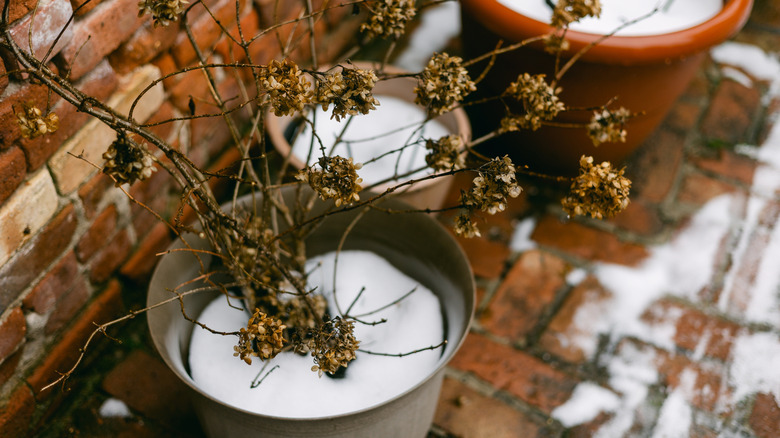The Best Place To Store Plants Outdoors To Keep Them Thriving In Winter Temps
Winter is around the corner. You've enjoyed your plants since spring, but you don't want to have to start all over again next spring. For many plants, that's no problem: trees, shrubs, bulbs, and many perennials that are adapted to your climate will do just fine. Other plants, including any perennials that are not suited for your hardiness zone, will need some protection to survive the winter. There's one spot outdoors that will give them the best chance of coming back next spring. If your plants are in pots but you're unable to bring all your perennials indoors for the winter, move them close to a wall, preferably a brick or cement wall such as a foundation, one that faces the sun and shields plants from the wind.
The challenge with potted plants is that they are more exposed to the elements than plants grown the ground. Without as much soil surrounding them, they dry out more quickly, and in the winter, the soil freezes more easily, exposing their root systems to harsher conditions. Placing your plants against a wall protects them from the wind, while the radiant heat from your home can provide some warmth. A house wall facing the sun will be warmer than one in the shade or the wall of an unheated building like a garage. A stone or brick wall is even better, as stone and brick absorb the sun's heat during the day and slowly release at night, allowing your plants to better resist the coldest nights.
Caring for your potted plants over the winter
The first tip for winterizing your perennials is to encourage them to go to sleep. Stop fertilizing them so that your plants can prepare for winter dormancy. Your plants will still need some water, especially if they retain their green leaves, which lose water through transpiration. But since your plants won't be growing during the winter, over-watering them will only encourage their roots to rot. Once you've moved your plants against a wall, place a three-inch layer of mulch around them, which will help them to retain warmth. Keep the mulch loose so that there are pockets of air that will trap heat — the same science behind feather down coats.
You can also protect them from the cold by giving them a blanket. You can use a fleece blanket or other breathable material to cover the plants at night, making sure to remove the covering during the day so that condensation doesn't build up inside, causing the plants to rot. You can also cover your plants with a makeshift greenhouse or make budget-friendly cloches to protect plants from frost using milk jugs, plastic cups, or other containers. Finally, you can surround the pot with burlap, loose straw or leaves, or piled-up mulch to reduce the threat of the pot and its contents freezing. But keep in mind the hardiness zone that your plants thrive best in. Some plants just won't make it if kept outdoors through the winter, despite your best efforts.

